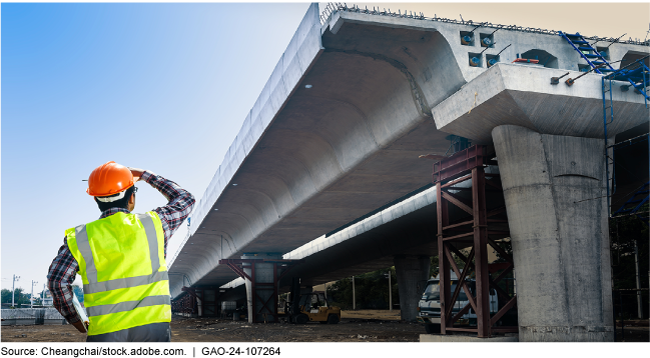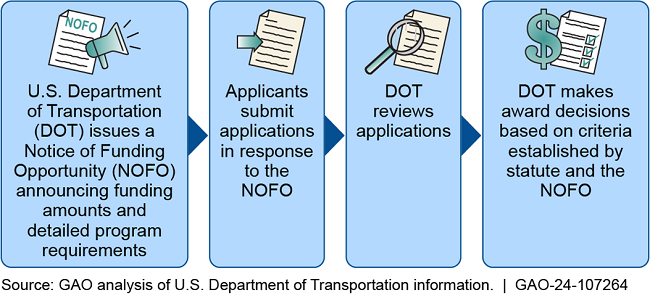Discretionary Grants: DOT Should Improve Clarity and Transparency of Program Management
Fast Facts
The nation's people and freight depend on an aging transportation system to keep moving. The Department of Transportation administers billions of dollars in competitive grants to improve it.
As the cost of transportation repairs exceeds the available funding, this Snapshot highlights the importance of using this money wisely. But we previously found that DOT's processes for reviewing grant applications and making award decisions wasn't documented properly and didn't fully align with federal requirements. 16 of our 17 recent recommendations remain open.
Funding the nation’s transportation system has been on GAO's High Risk list since 2007.

Highlights
DOT administers billions of dollars in discretionary grants to improve transportation in the United States. To help ensure that DOT awards these grants to projects that best support needed improvements, the agency should implement our recommendations to enhance the clarity and transparency of its award processes.
The Big Picture
The nation's surface transportation system that moves both people and freight is aging and faces increasing demands on its use. Due to its potential impacts on public safety and economic growth, funding the nation's surface transportation system has been on GAO's High Risk list since 2007. The cost of repairing and upgrading the system continues to exceed the revenues available for improvements. As such, we have highlighted the importance of spending surface transportation funding wisely and efficiently. This is particularly true for the Department of Transportation (DOT), which provides funding to states and other eligible entities. DOT awards some of this funding through competitive (discretionary) grants.
Typical DOT Discretionary Grant Application and Review Process

The Infrastructure Investment and Jobs Act (IIJA) provided about $540 billion in funding for surface transportation for fiscal years 2022 through 2026. According to DOT, this included over $110 billion for DOT discretionary grant programs.
We have recently reported on four of these programs. They received, in total, $24.5 billion in IIJA funding for fiscal years 2022 through 2026. These programs are: Rebuilding American Infrastructure with Sustainability and Equity (RAISE) ($7.5 billion), Infrastructure for Rebuilding America (INFRA) ($8 billion), Reconnecting Communities and Neighborhoods ($1 billion), and Capital Investment Grants (CIG) ($8 billion).
What GAO's Work Shows
We reported that in fiscal year 2022 (the first year of IIJA funding), DOT awarded about $3.75 billion through the RAISE and INFRA programs.
Award Totals for RAISE and INFRA Programs, by State and Territory, Fiscal Year 2022

Note: The total award amount shown on this map is about $3.75 billion. For fiscal year 2022, the INFRA program received funding from the IIJA and the RAISE program received funding from the IIJA and the Consolidated Appropriations Act, 2022. The map includes awards to all recipients within a state.
As of April 2024, DOT announced an additional $5.2 billion (rounded to the nearest ten million) in awards in the next funding rounds for these two programs.
- $2.3 billion in awards for 162 projects throughthe RAISE program for fiscal year 2023.
- $2.9 billion in awards for 28 projects throughthe INFRA program for fiscal years 2023 and 2024.
In work issued both before and after the passage of the IIJA, we found that DOT’s administration of discretionary grant programs did not always align with requirements set by the Office of Management and Budget and DOT, respectively, raising concerns over their consistency and transparency. For example:
Inconsistent documentation. We found that while DOT generally followed the processes outlined in the notice of funding opportunity (NOFO) and its own internal guidance when evaluating INFRA applications, DOT did not consistently provide complete and accurate documentation on its evaluation process. This documentation would better ensure DOT’s consistent implementation of its policies as designed.
Insufficient transparency. We found that DOT’s process for evaluating RAISE applications did not fully align with federal regulations and DOT guidance for ensuring the fairness and transparency of discretionary grant programs. For example, DOT did not publicly disclose two selection factors used to make award decisions in its NOFO. In addition, the Federal Transit Administration (FTA), which administers the CIG program, did not always provide project sponsors with clear information on its methods or the factors it considered when reviewing projects.
Challenges and Opportunities
From July 2020 through January 2024, we made 17 recommendations to improve the management of these four programs. As of February 2024, 16 of these recommendations remain open or partially open. Open recommendations include that:
- DOT identify all selection factors in its RAISE NOFO and document its specific rationale for not selecting certain projects;
- DOT establish quality control procedures to verify that its documentation is complete and clearly define its “exemplary project” criteria for advancing INFRA applications for potential selection;
- DOT establish performance measures for, and evaluate the results of, its Reconnecting Communities Pilot program; and
- FTA take steps to clarify the methods it uses and factors it considers when reviewing projects for CIG grants, and to communicate information to sponsors in a timely manner.
Additionally, in 2016 we recommended that DOT issue department-wide requirements for discretionary grant programs. We made this recommendation based on finding similar documentation and transparency challenges in the administration of discretionary grant programs DOT awarded to improve the resilience of transit systems following Hurricane Sandy. We recommended requirements to document key decisions and to develop a plan for evaluating project proposals, including how the process will ensure a consistent review of applications. We subsequently designated this as a priority recommendation. In February 2024, DOT officials said that they are targeting the end of the calendar year to implement the recommendation.
For more information, contact: Elizabeth Repko, RepkoE@gao.gov, (202) 512-2834.
